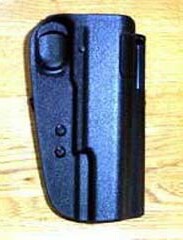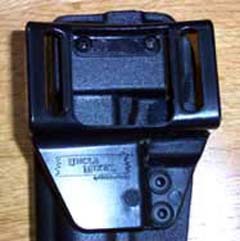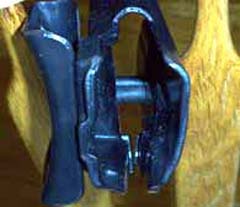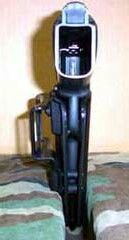|
One of the more recent
developments in the gun world has been the proliferation of hard
molded synthetic handgun holsters.
Where once one's holster selection was limited to softer
fabrics and the hides of cows and horses, today's handgunner can
pick from almost any material imaginable that can be tooled to
hold a handgun.
Gun owners, after an initial
bit of sneering, quickly took to polymer-framed handguns, so why
not polymer holsters? A
quick look at the holster selection of any gun store or at the
hips of shooters at an IDPA match will tell you that
polymer gunleather, although a contradiction in terms, is here
to stay. Synthetic
holsters are lighter than leather, and are unaffected by
anything a shooter could use on his guns short of industrial
solvents. Once
prices settled and quality was established, shooters liked what
they saw and synthetic holsters took off.
A quick look on the internet
finds prices for synthetic holsters anywhere from the high teens
to upwards of seventy bucks.
Any handgunner eventually ends up with a boxful of
holsters, and it's a constant battle to keep the box small.
As someone who once dropped $75 on a beautiful Galco
holster he barely wears, the idea of spending big money on his
first experience with polymer holsters was a little daunting.
On the lower end of the price scale for polymer holsters
is the Uncle Mike's line. Cheap doesn't always mean bad,
would it in this case?
In that end, I bought an Uncle
Mike's Kydex® belt holster for $19.95 from a local gun store.
I bought the model for the 5" 1911A1, intending to
use it as a range, and possible carry holster for my Jim
Stroh (www.alphaprecision.com)
tuned Para Ordnance P16-40 Ltd.
The belt slide version is just one on Uncle Mike's line
of Kydex® holsters, which also includes paddle holsters and
versions of the belt holsters with thumb breaks. Holsters are available for many popular handguns, including Glocks,
1911 clones, Beretta 92/96 series, and Smith &
Wesson 5900's.
The belt slide is listed as
working for belts between 1" and 1.75", and covers it
neatly with two sets of slots built into the frame.
The 1.5" leather belt I wear daily fit the smaller
slots firmly. Fans
of a forward rake are going to be a little disappointed as the
holster sits nearly vertically.
I normally find a slight (15 to 20 degree) forward rake,
the "FBI tilt", a little more comfortable to wear and
easier to conceal with a larger handgun, but the vertical draw
seems to be slightly faster, at least for me.
Straight out of the box, the
holster showed impressive fit and finish for the price paid.
Uncle Mike's makes their Kydex® holsters by using
injection molding, which they state on their website is both
cheaper and more consistent than forming from a sheet of stock Kydex®.
The pistol fits firmly into
the holster with an audible click as the front of the trigger
guard engages two small hooks.
At first I noticed a little shaving of the plastic on the
holster where the front of the trigger guard hits it, but a half
turn of the retention screw seemed to take care of this without
noticeable effect on retention.
I also noticed a little bit of bulging towards the rear,
which is due to the beefy Para's frame being wider than a normal
1911, but again, a quick tweak of the screw fixed this.
The molding is neatly done, closely following the
contours of the pistol, from the trigger guard to dust cover and
the ejection port.
Release was as smooth as you
can make it. A firm
and quick snap of the wrist upwards, and the pistol came
smoothly out. The
front of the Uncle Mike's holster is thoughtfully cut down to
just forward of the ejection port, which reduces how much
vertical movement is needed before the handgun can be thrust out
and brought up on target.
Being used to thumb straps, I
was a little concerned about retention.
I have used leather holsters without any retention
features before, and was not pleased.
The absolute last thing you want to happen in a heated
situation, which I have seen first hand, is to reach down to
draw and find that your handgun has gone bouncing off somewhere.
At the same time, for the average citizen a level 3
police duty holster is ridiculous overkill. The fine medium is then a holster that keeps the pistol
firmly at hand until you need it, then hands it over quickly. In my book, this means at the minimum a retention screw or a
thumb break. Kydex® holsters like the Uncle Mike's tested here use the
material, molded to a tight fit on the specific handgun, to do
this.
After triple checking (safety
first) the Para, I popped it in the holster and shook it over a
well-padded couch. Even upside down, it stayed in for several shakes.
By that point the wearer would probably be feeling like a
milkshake, but he'll still be armed.
One thing to remember on these
holsters, and those like them, is to use a quality belt and wear
that belt firmly. Not
uncomfortable or blood drawing tight, but firmly enough so that
the holster stays where you want it to, and is anchored to
release the pistol when drawn.
At the minimum, a leather belt should be 1 1/4" inch
wide at at least 1/8" thick.
A respected instructor once suggested to me that you
should not be able to bend the belt to touch the top to the
bottom, and that's good advice no matter the material.
A well-constructed nylon belt will also work, and while
fine in a casual or range setting, some folks may need something
a tad dressier. Some
holster makers, including Galco and Aker, are
making dressy leather belts with polymer inserts for stiffness,
but be prepared to pay for it.
When the belt is expected to hold up 20 or more ounces of
gun, holster, and other modern accoutrements, the least you can
do is get a good one.
Compared to some other similar
holsters, the Uncle Mike's belt slide sticks out slightly more
away from the body, which really is my one complaint about it.
I really noticed this when wearing it under a suit coat,
less so when worn openly or under a windbreaker.
I'm a little on the thin side and generally like my
holsters close to my body, so it's a bit of an adjustment.
The belt slide is screwed to a separate holster frame,
which while helping interchangeability and keeping costs lower,
makes it a bit more bulky.
Other holsters have molded-in belt loops, but they are
significantly more expensive.
It's all a matter of what works for the individual.
Uncle Mike's Kydex® holsters
are a well-built and utilitarian carry option at an excellent
price. For those
wanting an introduction to the world of synthetic holsters, or
those just wanting a good general purpose holster without
spending a whole bunch of money, they're hard to beat.
Check out the entire Uncle
Mike's line at www.uncle-mikes.com.
Erik Johnson
  
Got something to say about this article? Want to agree (or
disagree) with it? Click the following link to go to the GUNBlast Feedback Page.
All content © 2003 GunBlast.com.
All rights reserved. |
|

While they may not be appealing to traditionalists,
Uncle Mike's line of Kydex® holsters represent good quality
and value for the dollar.

A look at the back side of the holster shows its
versatility.

The injection-molded holster is a good fit for a
"standard" gun, and is easily adjustable to fit
wider-framed guns such as the author's Para Ordnance
double-stack 1911 derivative. Shown is a view of the top of
the holster.



Front view (top), rear view (center), and side view
(bottom) of the Uncle Mike's holster with the author's Para
Ordnance pistol. After initial adjustment, author was pleased
with the fit and retention of the holster; his only complaint
was that the holster stands out from the body a bit more than
more conventional designs. Erik recommends the Uncle Mike's
product for shooters seeking an inexpensive alternative to
leather.
|
![]()